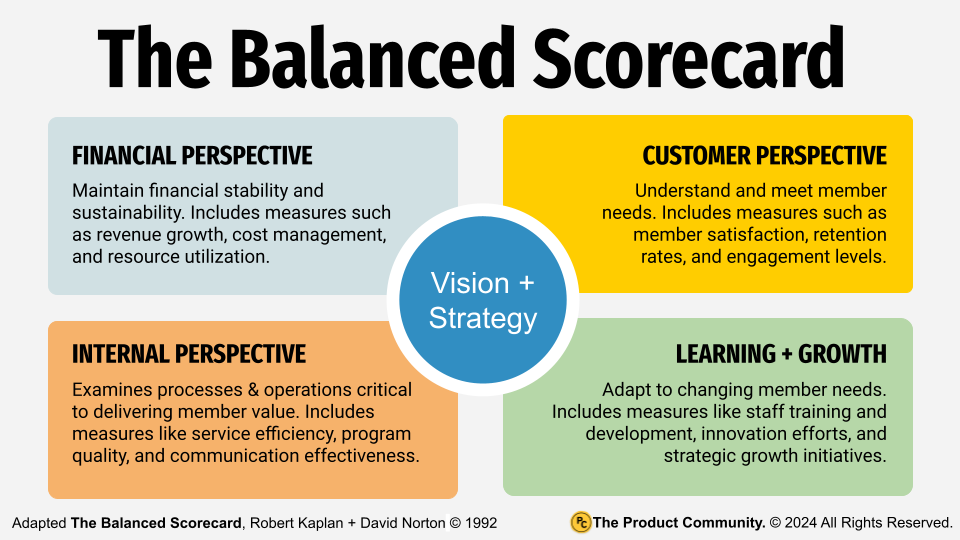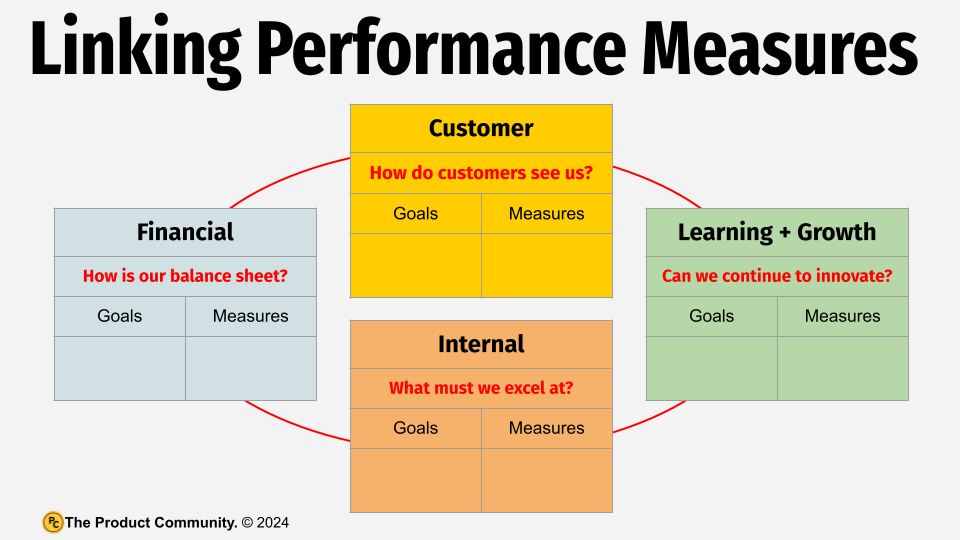Summary
“The scorecard puts strategy and vision, not control, at the center.”
Robert Kaplan and David Norton
As readers of this newsletter know, I’m a strategy guy. This is partly innate and partly due to being a long-term consumer of ideas, frameworks, and thinkers from the strategy literature. As part of this mindset, I’m a big fan of learning from tangent fields or industries to help inform our association work.
This article provides an overview of the balanced scorecard (originally developed by Robert Kaplan and David Norton) and how it can be applied to associations looking for a high-level yet meaningful snapshot of how they’re doing. The framework focuses our work across four perspectives: financial, customer, internal processes, and learning and growth.
I lead the product community, which is a product development learning community designed specifically for associations.
What is Balanced Scorecard?
“Think of the balanced scorecard as the dials and indicators in an airplane cockpit. For the complex task of navigating and flying an airplane, pilots need detailed information about many aspects of the flight. They need information on fuel, air speed, altitude, bearing, destination, and other indicators that summarize the current and predicted environment. Reliance on one instrument can be fatal.”
Robert Kaplan and David Norton
There are a million (minor exaggeration) ways to measure performance. I have written several articles outlining the importance of investing in metrics as a way of gauging our efficiency, market reach, growth, performance, outcomes, and impact:
Thirty Six Performance Metrics: Practical Tools to Measure Association Impact
Measuring Community Engagement: A Practical Approach to Association Vibrancy
Outcomes for Impact: Making Progress on Hard to Solve Problems
Measure What Matters: A Practical Approach to Association Metrics
The balanced scorecard is a strategic performance framework that helps organizations translate their vision and strategy into actionable objectives and measures across four interconnected perspectives: financial, customer, internal processes, and learning and growth.
For membership-driven organizations like associations, the balanced scorecard can be an effective tool to align the organization's activities with its mission and goals, while considering the needs and expectations of its members. Here's how it can be applied:
Financial Perspective – While associations are non-profit organizations, they still need to maintain financial stability and sustainability. The financial perspective includes measures such as revenue growth, cost management, and resource utilization.
Member (Customer) Perspective – This perspective focuses on understanding and meeting the needs of the association's members. Measures include member satisfaction, retention rates, and engagement levels.
Internal Processes Perspective – This perspective examines the internal processes and operations critical for delivering value to members. Measures include the efficiency of member services, quality of programs, and effectiveness of communication.
Learning and Growth Perspective – This perspective looks at the organization's ability to continuously improve and adapt to changing member needs and industry trends. Measures could include employee training and development, innovation efforts, and knowledge management initiatives.
By using the balanced scorecard, associations can:
Align their strategic objectives with the needs and expectations of their members.
Identify and track key performance indicators (KPIs) that reflect their mission and goals.
Balance and integrate different perspectives to ensure a holistic approach to performance management.
Communicate the organization's strategy and objectives to all stakeholders, including staff, volunteers, and members.
Promote accountability and continuous improvement by regularly reviewing and adjusting the scorecard.
It's important to note that the specific measures and targets within each perspective should be tailored to the unique context and priorities of each particular association. Additionally, effective implementation of the balanced scorecard requires buy-in from leadership, clear communication, and a culture of performance measurement and improvement.
What are Your Priorities? An Association Example
“The cultural imprint is strong; people do what the culture asks them to do. Culture drives outcomes across the organizational scorecard. Performance, engagement, retention, innovation, and growth are all affected by culture.”
Josh Bersin
For the fictitious Society of Apple Growers, the balanced scorecard could be used to communicate performance to its diverse stakeholders – board, volunteers, members, and the larger community – through the lens of the four perspectives, with sample goals and measures as follows:
Financial Perspective
Goal: Ensure financial sustainability and growth.
Measures:
Annual revenue growth from membership dues and events
Cost efficiency ratio (operating expenses/total revenue)
Fundraising performance (funds raised/funds targeted)
Member (Customer) Perspective
Goal: Enhance member satisfaction and engagement.
Measures:
Member retention rate
Member satisfaction survey scores
Participation rates in events and programs
Net Promoter Score (likelihood of members recommending the association)
Internal Processes Perspective
Goal: Optimize core operations and service delivery.
Measures:
Efficiency of membership management processes (e.g., response time, accuracy)
Quality and relevance of educational programs and resources
Effectiveness of communication channels (e.g., website traffic, email open rates)
Turnaround time for addressing member inquiries and complaints
Learning and Growth Perspective
Goal: Foster continuous improvement and innovation.
Measures:
Employee and volunteer training hours
Investment in research and development (e.g., new technologies, best practices)
Number of process improvement initiatives implemented
Employee and volunteer satisfaction and engagement scores
Perhaps most important to the Society of Apple Growers is to think of the four perspectives of the balanced scorecard as an integrative system. In this way, we can start to tease out connections, rationales, and explanations for why the results of our metrics have turned out the way they did.
By communicating these goals and measures across the four perspectives, the Society of Apple Growers can provide a comprehensive view of its performance to its stakeholders:
Board – The balanced scorecard can help the board oversee the association's strategic direction, resource allocation, and overall performance.
Volunteers – Volunteers can understand how their contributions align with the association's goals and impact various aspects of performance.
Members – Members can see how the association is delivering value and addressing their needs, fostering transparency and accountability.
Community – The balanced scorecard can demonstrate the association's commitment to responsible stewardship, continuous improvement, and positive impact on the apple-growing industry and the broader community.
By regularly reviewing and updating the balanced scorecard, the Society of Apple Growers can identify areas for improvement, make data-driven decisions, and communicate its progress and achievements effectively to its diverse stakeholders.
Finding the Right Balance
“The things that often create the most value are intangible and difficult to measure and track.”
Robert Simons
The balanced scorecard has been implemented for about three decades to evaluate and improve the performance of organizations of all kinds.
Though I love strategy and consider myself a metric nerd, I’ve never been a fan of the phrase data-driven. I’ve been in the work world for thirty-some years and only once have I experienced good, clean, usable data.
But, this doesn’t mean we shouldn’t try!
I much prefer the phrase data-informed as I believe we can be choosy in what we measure and disciplined in how we measure it. This way, our data lake can be focused on the things that matter the most and our outcome measures can be contained and usable. Just make sure to watch the blindspots; over-focusing on data or teasing out meaning where it might not exist can be dangerous.
And, of course, we must always remember why we use metric frameworks like the balanced scorecard. It’s so we can be people-centric, diversify our revenue, and serve our members with superior performance.
I lead the product community; we are a learning community because we believe great relationships help us create the value our members want. Remember, product-led growth fuels connection. Join the product community and flip your destiny.
About the Author
James Young is founder and chief learning officer of the product community®. Jim is an engaging trainer and leading thinker in the worlds of associations, learning communities, and product development. Prior to starting the product community®, Jim served as Chief Learning Officer at both the American College of Chest Physicians and the Society of College and University Planning. Please contact me for a conversation: james@productcommunity.us






